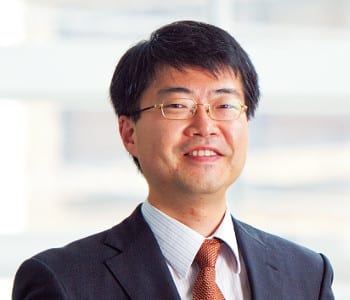 Takao Someya received his PhD in Electrical Engineering from the University of Tokyo in 1997, where he subsequently worked as Lecturer (1998-2001) and Associate Professor (2001-2009). From 2001 to 2002, he was a visiting scholar at Bell Labs, Lucent Technologies and at the Nanocenter (NSEC), Columbia University. Since 2009, he has been Professor at the Department of Electrical and Electronic Engineering at the University of Tokyo. His current research focuses on thin and flexible organic electronics, such as field-effect transistors, light emitting devices, solar cells, and organic devices for bio-medical applications.
Takao Someya received his PhD in Electrical Engineering from the University of Tokyo in 1997, where he subsequently worked as Lecturer (1998-2001) and Associate Professor (2001-2009). From 2001 to 2002, he was a visiting scholar at Bell Labs, Lucent Technologies and at the Nanocenter (NSEC), Columbia University. Since 2009, he has been Professor at the Department of Electrical and Electronic Engineering at the University of Tokyo. His current research focuses on thin and flexible organic electronics, such as field-effect transistors, light emitting devices, solar cells, and organic devices for bio-medical applications.
The launch of our new journal, Advanced Electronic Materials, addresses the growing global scientific interest in materials with unique electrical and magnetic properties, which is a key topic in materials science, device engineering, and physics.
How do you feel about your new role as a member of the Advanced Electronic Materials Editorial Advisory Board?
I am always considering new applications using organic semiconductors and other flexible nano materials; thereby, I hope that Advanced Electronic Materials will keep a good balance between fundamentals and applications.
Since 2009, you have been Professor of the Department of Electrical and Electronic Engineering at the University of Tokyo. What do you enjoy the most about running your own research group?
My research team consists of diverse and heterogenous researchers with various backgrounds and nationalities. We fully enjoy it when interactions lead us to create something brand new.
What advice would you give to a student who is planning a scientific career?
The frontier of science becomes extremely interdisciplinary. I believe that students should value their own expertise, and simultaneously be curious about other areas, and pursue collaborative research in a diverse team.
Your major research interests include organic transistors, flexible electronics, plastic integrated circuits, large-area sensors, and plastic actuators. To what extent have your research priorities changed, what have been the influences that contributed to these changes, and in which areas do you see considerable potential for future progress?
Our group expanded our target materials from inorganic to organic. At that time, we started exploring novel electronic materials such as soft and flexible organic semiconductors, and focusing more on the usability from users’ point of view rather than improvement of computing speed and/or storage capacity.
A part of your research deals with the investigation and development of novel bioelectronics, such as implantable bio-organic devices to visualize neuron activities or adhesive patches that enable monitoring of health conditions when attached to the skin surface. Keywords such as robotic skin still might sound like science fiction for most people. In your opinion, how long will it take until this research area finds its way into practical medical and healthcare applications?
It is exactly the right time for flexible electronics to emerge. Wearable flexible sensors with simple structure will ensure sufficient electronic performances as well as reliability required for practical use within coming 3 years. On the other hand, full-fledged biomedical devices with long-term stability must wait a longer period of time before they achieve practical applications.

















